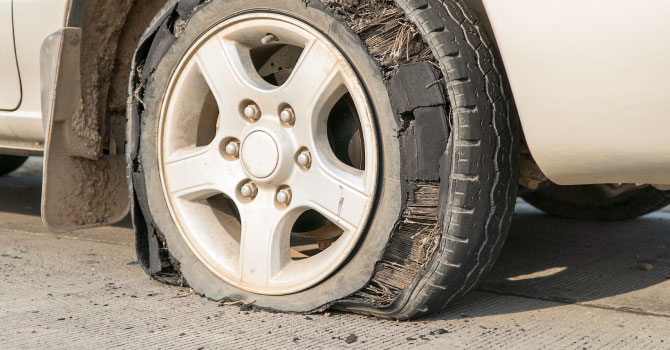Why Tire Blowouts Happen and How to Avoid Them
Summer temperatures in Arizona regularly exceed the one-hundred-degree mark. Conditions like this make tire blowouts much more common; are you prepared for the unexpected?
Arizona summers are notoriously hot. If you live here for an extended period then you are surely accustomed to the state’s harsh climate and the impact it has on everyday life. This heat can sure take some getting used to; as a driver, you need to be familiar with how such high temperatures affect your tires. So, how exactly does heat jeopardize tires?
The properties of your tires, and the air within them, rise in pressure when exposed to heat. At a physical level, temperature increases cause molecules inside your tires to expand and vibrate intensely. Not sure what this means?
Let’s look at the math. Tire pressure rises one pound per square inch (PSI) for each ten-degree Fahrenheit influx in temperature. That means summer highs hovering at the 117° F mark adds an additional seven pounds of pressure to your tires! And don’t forget excess heat caused by friction; contact with the road only adds to this rather alarming, and dangerous, phenomenon.
The consequences are undeniable; extra pressure within your tires during hot summers could lead to a blowout. Why? The chemical composition of rubber makes tires susceptible to breaking under extreme expansion. Minimal increases are unlikely to cause your tire to pop, but extreme over-inflation can cause internal wear which can drastically impact your car’s braking abilities. There are a few simple things worth considering as you eye the open road.
Always stay on top of the condition of your tires throughout the entire year. From general wear and tear to seasonal swings, ensuring your tires are in roadworthy condition throughout the entire year is critical. Prepare for the unknown by physically checking your tires regularly. Be sure to seek assistance if pressure levels exceed recommendations as determined by the manufacturer. Needless to say, you should check the pressure of your tires before any extended road trip. If you are concerned about overinflation then be sure to stop periodically during long drives to keep an eye on things before it is too late.
It’s important to note that drivers should not immediately release air from tires once they detect an overinflated tire as underinflated tires are also unsafe. The best thing to do is to pull over and wait for the temperature of your tires to normalize before releasing any air.
Don’t forget, it is essential to change your tires whenever the tread wears low. Why is it important? The tread on your tires not only ensures you have an adequate grip on the road surface but it also reduces the likelihood of a blowout as your tires will be thicker and stronger.
Unfortunately, there’s nothing we can do about the effects heat has on tires. By taking the right precautions and caring for your tires, you’ll be safer than ever. Thankfully, auXcar is at your side every step of the way. A single touch on this convenient app gives drivers access to an expansive network of automobile specialists within the area. Available anytime, anywhere, auXcar is ready to get you back on the road!




